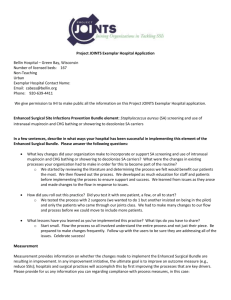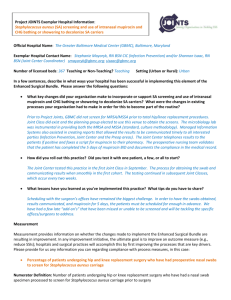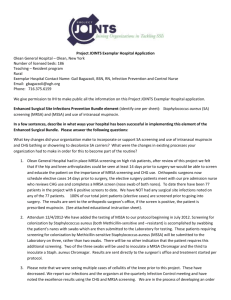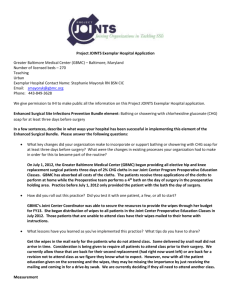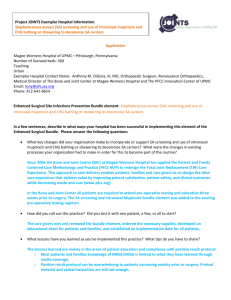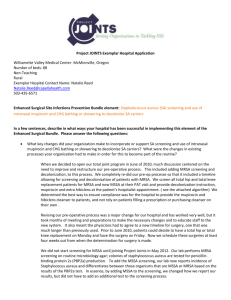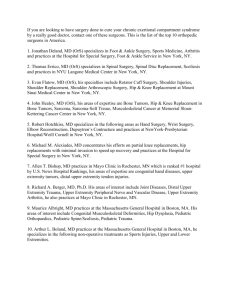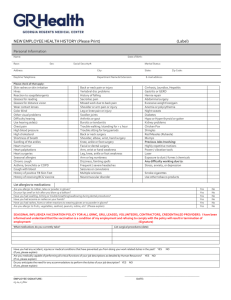Ministry St. Michael`s Hospital
advertisement
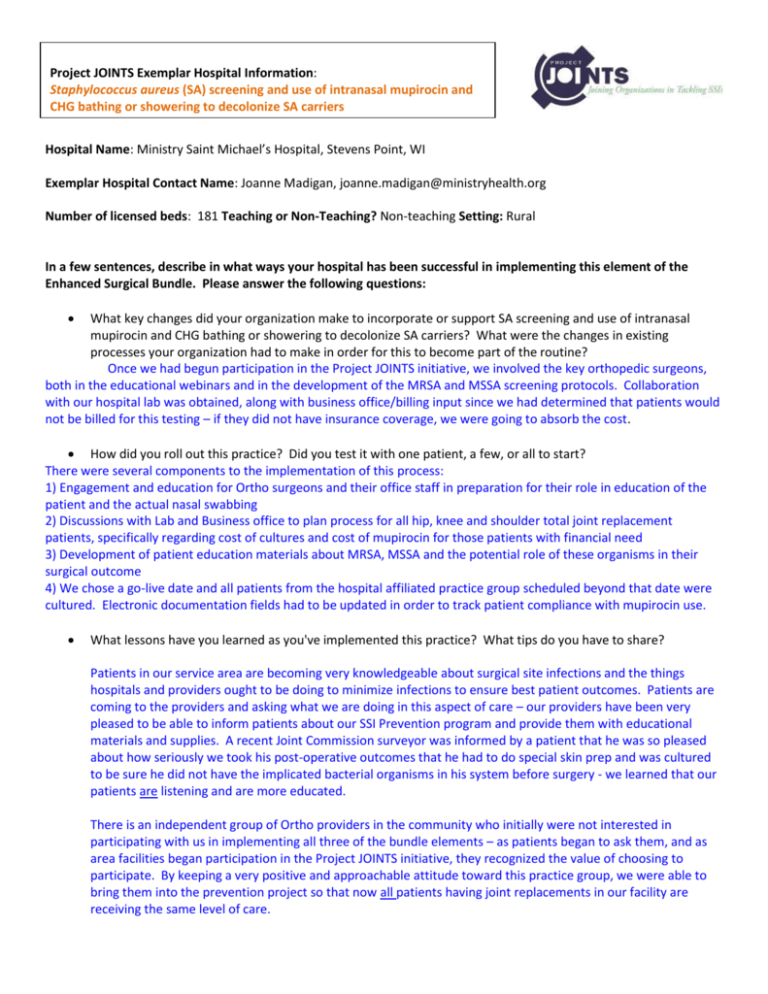
Project JOINTS Exemplar Hospital Information: Staphylococcus aureus (SA) screening and use of intranasal mupirocin and CHG bathing or showering to decolonize SA carriers Hospital Name: Ministry Saint Michael’s Hospital, Stevens Point, WI Exemplar Hospital Contact Name: Joanne Madigan, joanne.madigan@ministryhealth.org Number of licensed beds: 181 Teaching or Non-Teaching? Non-teaching Setting: Rural In a few sentences, describe in what ways your hospital has been successful in implementing this element of the Enhanced Surgical Bundle. Please answer the following questions: What key changes did your organization make to incorporate or support SA screening and use of intranasal mupirocin and CHG bathing or showering to decolonize SA carriers? What were the changes in existing processes your organization had to make in order for this to become part of the routine? Once we had begun participation in the Project JOINTS initiative, we involved the key orthopedic surgeons, both in the educational webinars and in the development of the MRSA and MSSA screening protocols. Collaboration with our hospital lab was obtained, along with business office/billing input since we had determined that patients would not be billed for this testing – if they did not have insurance coverage, we were going to absorb the cost. How did you roll out this practice? Did you test it with one patient, a few, or all to start? There were several components to the implementation of this process: 1) Engagement and education for Ortho surgeons and their office staff in preparation for their role in education of the patient and the actual nasal swabbing 2) Discussions with Lab and Business office to plan process for all hip, knee and shoulder total joint replacement patients, specifically regarding cost of cultures and cost of mupirocin for those patients with financial need 3) Development of patient education materials about MRSA, MSSA and the potential role of these organisms in their surgical outcome 4) We chose a go-live date and all patients from the hospital affiliated practice group scheduled beyond that date were cultured. Electronic documentation fields had to be updated in order to track patient compliance with mupirocin use. What lessons have you learned as you've implemented this practice? What tips do you have to share? Patients in our service area are becoming very knowledgeable about surgical site infections and the things hospitals and providers ought to be doing to minimize infections to ensure best patient outcomes. Patients are coming to the providers and asking what we are doing in this aspect of care – our providers have been very pleased to be able to inform patients about our SSI Prevention program and provide them with educational materials and supplies. A recent Joint Commission surveyor was informed by a patient that he was so pleased about how seriously we took his post-operative outcomes that he had to do special skin prep and was cultured to be sure he did not have the implicated bacterial organisms in his system before surgery - we learned that our patients are listening and are more educated. There is an independent group of Ortho providers in the community who initially were not interested in participating with us in implementing all three of the bundle elements – as patients began to ask them, and as area facilities began participation in the Project JOINTS initiative, they recognized the value of choosing to participate. By keeping a very positive and approachable attitude toward this practice group, we were able to bring them into the prevention project so that now all patients having joint replacements in our facility are receiving the same level of care. Measurement Measurement provides information on whether the changes made to implement the Enhanced Surgical Bundle are resulting in improvement. In any improvement initiative, the ultimate goal is to improve an outcome measure (e.g., reduce SSIs); hospitals and surgical practices will accomplish this by first improving the processes that are key drivers. Please provide for us any information you can regarding compliance with process measures, in this case: Percentage of patients undergoing hip and knee replacement surgery who have had preoperative nasal swabs to screen for Staphylococcus aureus carriage [screening measure] Data for time period September 2012 (implementation of process) – November 2012 51 patients – 100% screened Numerator Definition: Number of patients undergoing hip or knee replacement surgery who have had a nasal swab specimen processed to screen for Staphylococcus aureus carriage prior to surgery Denominator Definition: Number of patients undergoing elective hip or knee replacement surgery Percentage of patients undergoing hip and knee replacement surgery with nasal swabs positive for Staphylococcus aureus who have received five days of intranasal mupirocin prior to surgery [received mupirocin measure] Data for time period September 2012 (process implementation) – November 2012 6/8 = 75% (two patients with partial compliance, did not complete full 5 days) Numerator Definition: Number of patients undergoing hip or knee replacement surgery with a nasal swab specimen result indicating Staphylococcus aureus carriage who have received five days of intranasal mupirocin prior to surgery Denominator Definition: Number of patients undergoing elective hip or knee replacement surgery with nasal swabs positive for Staphylococcus aureus NOTE: Please attach available data in any format you currently have in the email included with this application. Surgical Site Infection Prevention Program Sept-Nov 2012 Mupirocin Volumes Cultured MRSA + MSSA + Ordered MMG 51 51 1 7 8 % Compliance 100% Patients completing 5 day RX 2 d CHG Shower 6 51 75% 100% Eve. Prior CHG DOS CHG on Adm 51 51 100% Note: Independent practice group began CHG bathing protocol and nasal swabbing with mupirocin treatment for MSSA/MRSA positive cultures in December 2012. Next reporting cycle will include data from each of the two provider groups. 100%
